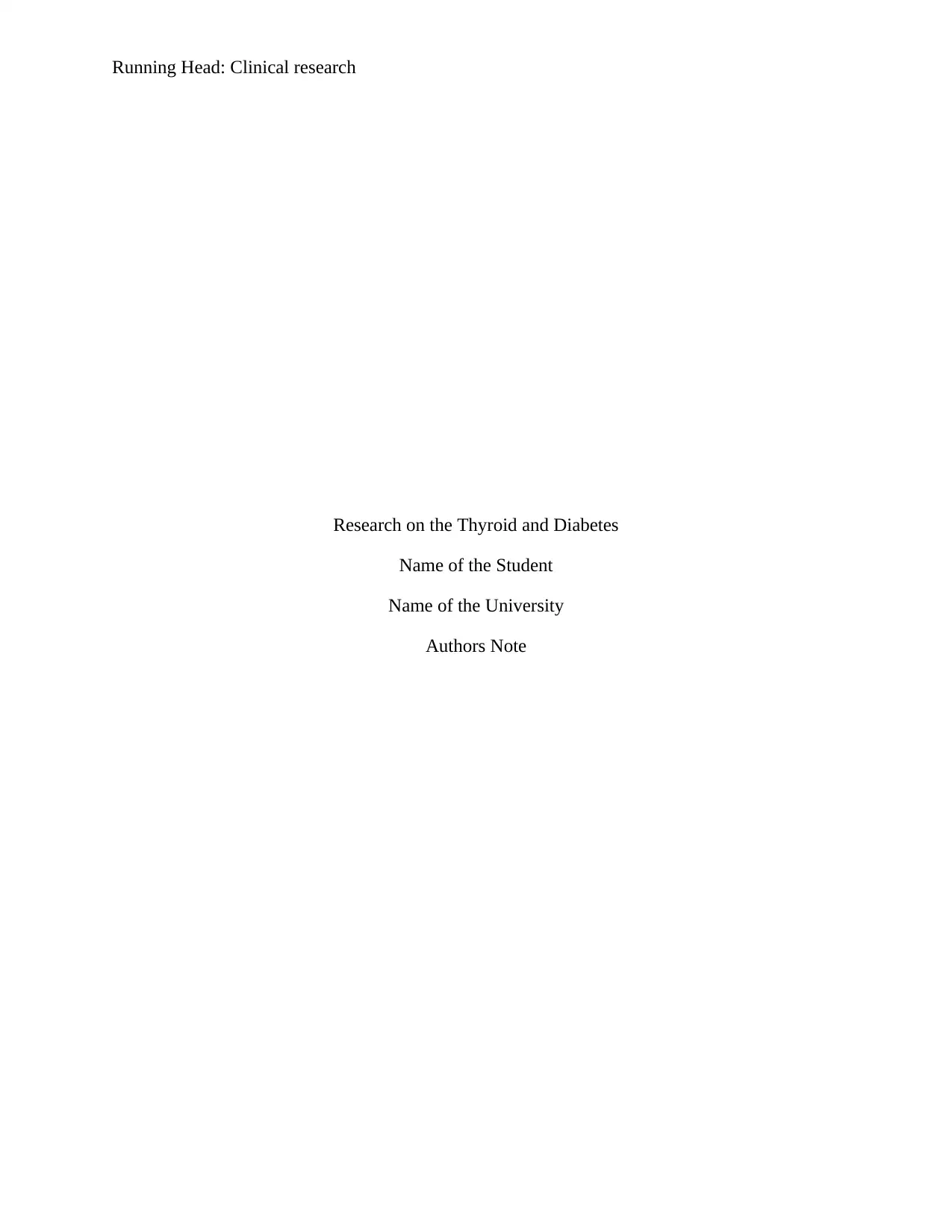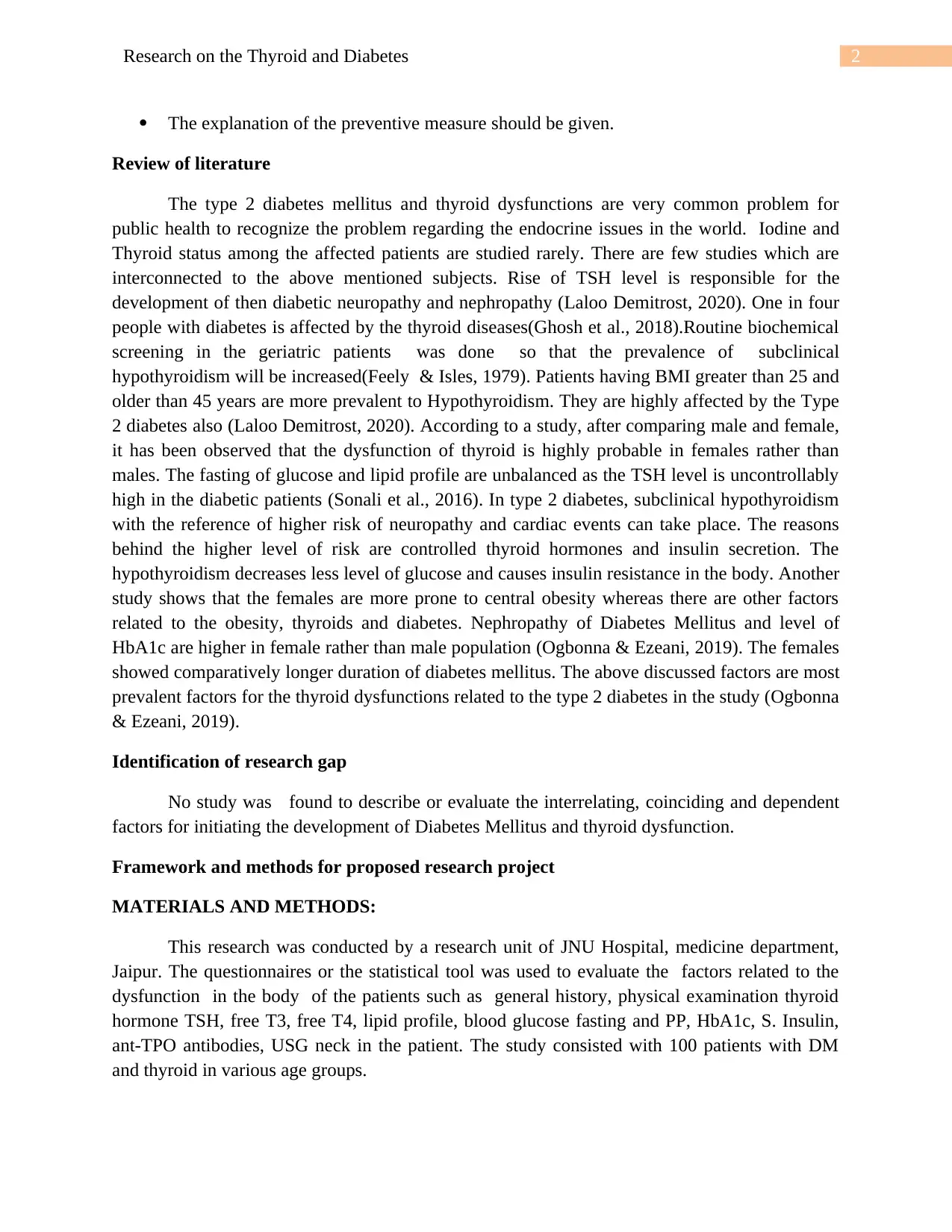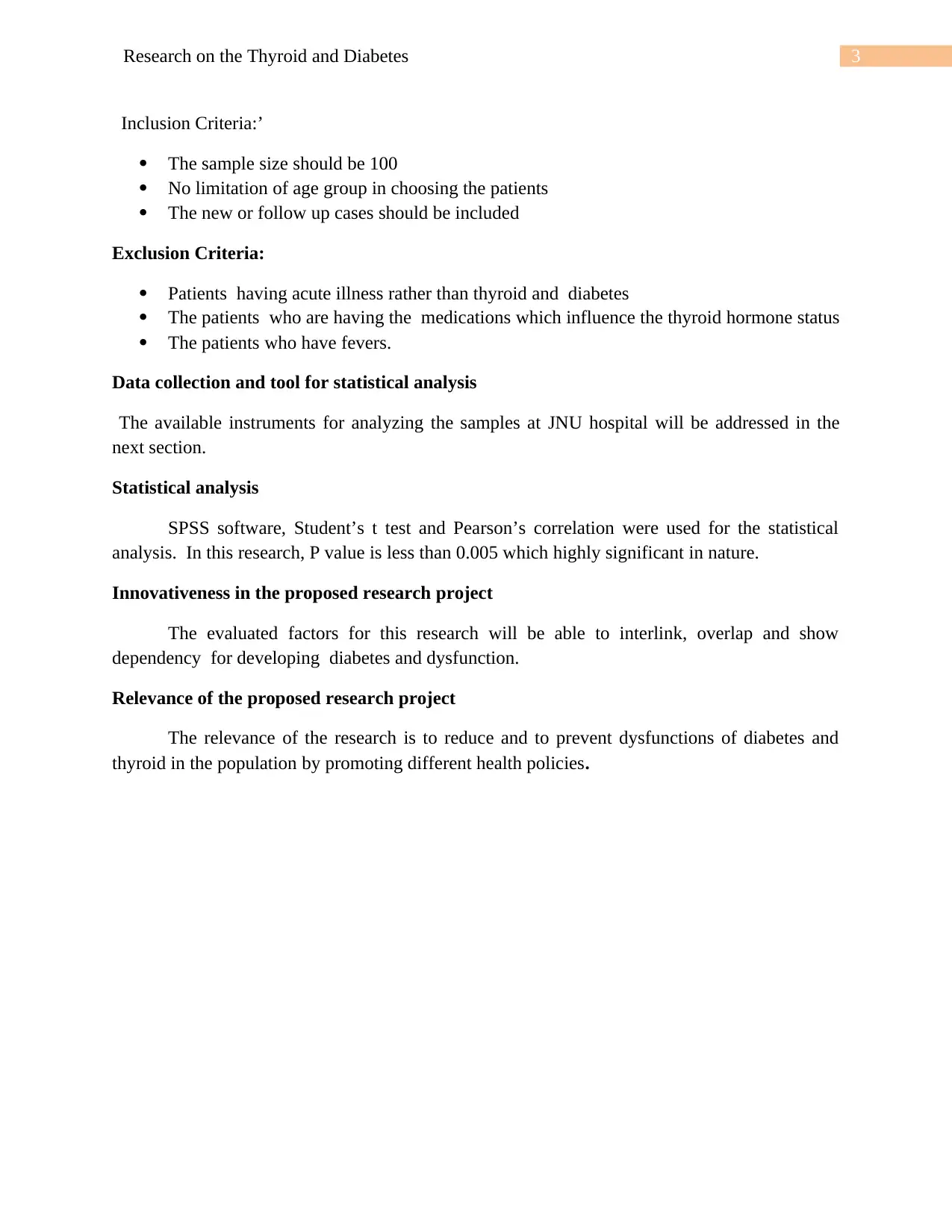Evaluating Risk Factors: Diabetes and Thyroid Dysfunction Research
VerifiedAdded on 2022/08/08
|5
|1414
|17
Report
AI Summary
This research report, conducted at JNU Hospital, investigates the intricate relationship between diabetes mellitus and thyroid dysfunction, often referred to as thyrobetes. The study aims to identify the overlapping and interdependent factors that contribute to the development of both conditions. The r...

Running Head: Clinical research
Research on the Thyroid and Diabetes
Name of the Student
Name of the University
Authors Note
Research on the Thyroid and Diabetes
Name of the Student
Name of the University
Authors Note
Paraphrase This Document
Need a fresh take? Get an instant paraphrase of this document with our AI Paraphraser

1Research on the Thyroid and Diabetes
Introduction
Men are healthier in comparison to female. According to the GOQii, this year diabetes
has been increased form 7.1% to 12%. The incidence of the diabetes is highest in the older adults.
From different statistical reports approximately 23.81 per cent older adults are affected by the
diabetes mellitus whereas the 36.82 percent seniors are affected by this disease. Approximately
13.5 percent of Indians are suffering from high cholesterol issues. In the previous year’s studies,
thyroid related disorders are increased from 6.8 to 10.7 per cent.
The relationship between thyroid disease and diabetes is known as thyrobetes. Several
environmental dysfunctions can be seen due to the up rise of diabetes and thyroid dysfunctions.
From 1927 the association of the hypothyroidism and declination of diabetes was started.
The question can be arrived on the onset of the above discussed situation that;
Are the risks related to the development of diabetes responsible for thyroid disease and is
development of thyroid relate d risk cause diabetes?
Both of the diseases are over lapped each other due to their mutual disruptive relationship.
Hyperthyroidism: In this condition the glucose breaks down into glycogen after coming out
of the liver. The production of glycogen is caused by the insulin resistance and intolerance of
glucose. In development of the Type 2 Diabetes, high level of T3 hormone will increase the risk of
occurrence.
Hypothyroidism: In this condition the glycemic index is reduced due to the glucose
absorption. The liver produces less amount of glucose so that the blood glucose level increases. The
body processes enough amount of glucose due to the effect of gluconeogenesis. However, the brain
craves for more energy as the result of lack of diet and occurrence of the gluconeogenesis. The
muscles produce less glucose and the insulin resistance low HDL. If the TSH level is 2.5 or more
than that , the risk of occurrence of diabetes can be observed and the function of beta cells can be
reduced. As a result, the insulin resistance will be increased for decline rate of function of beta cell.
T3 controls the gene GLUT4 and transporter of glucose in the body. T3 can induce the level of
passive and insulin mediated transportation of glucose.
Objective of the study
The objectives of the study are
To find out the interrelation of the factors which are responsible for the connection among
development of diabetes and thyroid disease.
TSH, free T3, free T4, lipid profile, blood glucose fasting and PP, HbA1c, S. Insulin, ant-
TPO antibodies, USG neck should be estimated for patients to detect the rate of the
thyroid.
Correlating factors for development of diabetes and thyroid diseases should be identified.
Introduction
Men are healthier in comparison to female. According to the GOQii, this year diabetes
has been increased form 7.1% to 12%. The incidence of the diabetes is highest in the older adults.
From different statistical reports approximately 23.81 per cent older adults are affected by the
diabetes mellitus whereas the 36.82 percent seniors are affected by this disease. Approximately
13.5 percent of Indians are suffering from high cholesterol issues. In the previous year’s studies,
thyroid related disorders are increased from 6.8 to 10.7 per cent.
The relationship between thyroid disease and diabetes is known as thyrobetes. Several
environmental dysfunctions can be seen due to the up rise of diabetes and thyroid dysfunctions.
From 1927 the association of the hypothyroidism and declination of diabetes was started.
The question can be arrived on the onset of the above discussed situation that;
Are the risks related to the development of diabetes responsible for thyroid disease and is
development of thyroid relate d risk cause diabetes?
Both of the diseases are over lapped each other due to their mutual disruptive relationship.
Hyperthyroidism: In this condition the glucose breaks down into glycogen after coming out
of the liver. The production of glycogen is caused by the insulin resistance and intolerance of
glucose. In development of the Type 2 Diabetes, high level of T3 hormone will increase the risk of
occurrence.
Hypothyroidism: In this condition the glycemic index is reduced due to the glucose
absorption. The liver produces less amount of glucose so that the blood glucose level increases. The
body processes enough amount of glucose due to the effect of gluconeogenesis. However, the brain
craves for more energy as the result of lack of diet and occurrence of the gluconeogenesis. The
muscles produce less glucose and the insulin resistance low HDL. If the TSH level is 2.5 or more
than that , the risk of occurrence of diabetes can be observed and the function of beta cells can be
reduced. As a result, the insulin resistance will be increased for decline rate of function of beta cell.
T3 controls the gene GLUT4 and transporter of glucose in the body. T3 can induce the level of
passive and insulin mediated transportation of glucose.
Objective of the study
The objectives of the study are
To find out the interrelation of the factors which are responsible for the connection among
development of diabetes and thyroid disease.
TSH, free T3, free T4, lipid profile, blood glucose fasting and PP, HbA1c, S. Insulin, ant-
TPO antibodies, USG neck should be estimated for patients to detect the rate of the
thyroid.
Correlating factors for development of diabetes and thyroid diseases should be identified.

2Research on the Thyroid and Diabetes
The explanation of the preventive measure should be given.
Review of literature
The type 2 diabetes mellitus and thyroid dysfunctions are very common problem for
public health to recognize the problem regarding the endocrine issues in the world. Iodine and
Thyroid status among the affected patients are studied rarely. There are few studies which are
interconnected to the above mentioned subjects. Rise of TSH level is responsible for the
development of then diabetic neuropathy and nephropathy (Laloo Demitrost, 2020). One in four
people with diabetes is affected by the thyroid diseases(Ghosh et al., 2018).Routine biochemical
screening in the geriatric patients was done so that the prevalence of subclinical
hypothyroidism will be increased(Feely & Isles, 1979). Patients having BMI greater than 25 and
older than 45 years are more prevalent to Hypothyroidism. They are highly affected by the Type
2 diabetes also (Laloo Demitrost, 2020). According to a study, after comparing male and female,
it has been observed that the dysfunction of thyroid is highly probable in females rather than
males. The fasting of glucose and lipid profile are unbalanced as the TSH level is uncontrollably
high in the diabetic patients (Sonali et al., 2016). In type 2 diabetes, subclinical hypothyroidism
with the reference of higher risk of neuropathy and cardiac events can take place. The reasons
behind the higher level of risk are controlled thyroid hormones and insulin secretion. The
hypothyroidism decreases less level of glucose and causes insulin resistance in the body. Another
study shows that the females are more prone to central obesity whereas there are other factors
related to the obesity, thyroids and diabetes. Nephropathy of Diabetes Mellitus and level of
HbA1c are higher in female rather than male population (Ogbonna & Ezeani, 2019). The females
showed comparatively longer duration of diabetes mellitus. The above discussed factors are most
prevalent factors for the thyroid dysfunctions related to the type 2 diabetes in the study (Ogbonna
& Ezeani, 2019).
Identification of research gap
No study was found to describe or evaluate the interrelating, coinciding and dependent
factors for initiating the development of Diabetes Mellitus and thyroid dysfunction.
Framework and methods for proposed research project
MATERIALS AND METHODS:
This research was conducted by a research unit of JNU Hospital, medicine department,
Jaipur. The questionnaires or the statistical tool was used to evaluate the factors related to the
dysfunction in the body of the patients such as general history, physical examination thyroid
hormone TSH, free T3, free T4, lipid profile, blood glucose fasting and PP, HbA1c, S. Insulin,
ant-TPO antibodies, USG neck in the patient. The study consisted with 100 patients with DM
and thyroid in various age groups.
The explanation of the preventive measure should be given.
Review of literature
The type 2 diabetes mellitus and thyroid dysfunctions are very common problem for
public health to recognize the problem regarding the endocrine issues in the world. Iodine and
Thyroid status among the affected patients are studied rarely. There are few studies which are
interconnected to the above mentioned subjects. Rise of TSH level is responsible for the
development of then diabetic neuropathy and nephropathy (Laloo Demitrost, 2020). One in four
people with diabetes is affected by the thyroid diseases(Ghosh et al., 2018).Routine biochemical
screening in the geriatric patients was done so that the prevalence of subclinical
hypothyroidism will be increased(Feely & Isles, 1979). Patients having BMI greater than 25 and
older than 45 years are more prevalent to Hypothyroidism. They are highly affected by the Type
2 diabetes also (Laloo Demitrost, 2020). According to a study, after comparing male and female,
it has been observed that the dysfunction of thyroid is highly probable in females rather than
males. The fasting of glucose and lipid profile are unbalanced as the TSH level is uncontrollably
high in the diabetic patients (Sonali et al., 2016). In type 2 diabetes, subclinical hypothyroidism
with the reference of higher risk of neuropathy and cardiac events can take place. The reasons
behind the higher level of risk are controlled thyroid hormones and insulin secretion. The
hypothyroidism decreases less level of glucose and causes insulin resistance in the body. Another
study shows that the females are more prone to central obesity whereas there are other factors
related to the obesity, thyroids and diabetes. Nephropathy of Diabetes Mellitus and level of
HbA1c are higher in female rather than male population (Ogbonna & Ezeani, 2019). The females
showed comparatively longer duration of diabetes mellitus. The above discussed factors are most
prevalent factors for the thyroid dysfunctions related to the type 2 diabetes in the study (Ogbonna
& Ezeani, 2019).
Identification of research gap
No study was found to describe or evaluate the interrelating, coinciding and dependent
factors for initiating the development of Diabetes Mellitus and thyroid dysfunction.
Framework and methods for proposed research project
MATERIALS AND METHODS:
This research was conducted by a research unit of JNU Hospital, medicine department,
Jaipur. The questionnaires or the statistical tool was used to evaluate the factors related to the
dysfunction in the body of the patients such as general history, physical examination thyroid
hormone TSH, free T3, free T4, lipid profile, blood glucose fasting and PP, HbA1c, S. Insulin,
ant-TPO antibodies, USG neck in the patient. The study consisted with 100 patients with DM
and thyroid in various age groups.
⊘ This is a preview!⊘
Do you want full access?
Subscribe today to unlock all pages.

Trusted by 1+ million students worldwide

3Research on the Thyroid and Diabetes
Inclusion Criteria:’
The sample size should be 100
No limitation of age group in choosing the patients
The new or follow up cases should be included
Exclusion Criteria:
Patients having acute illness rather than thyroid and diabetes
The patients who are having the medications which influence the thyroid hormone status
The patients who have fevers.
Data collection and tool for statistical analysis
The available instruments for analyzing the samples at JNU hospital will be addressed in the
next section.
Statistical analysis
SPSS software, Student’s t test and Pearson’s correlation were used for the statistical
analysis. In this research, P value is less than 0.005 which highly significant in nature.
Innovativeness in the proposed research project
The evaluated factors for this research will be able to interlink, overlap and show
dependency for developing diabetes and dysfunction.
Relevance of the proposed research project
The relevance of the research is to reduce and to prevent dysfunctions of diabetes and
thyroid in the population by promoting different health policies.
Inclusion Criteria:’
The sample size should be 100
No limitation of age group in choosing the patients
The new or follow up cases should be included
Exclusion Criteria:
Patients having acute illness rather than thyroid and diabetes
The patients who are having the medications which influence the thyroid hormone status
The patients who have fevers.
Data collection and tool for statistical analysis
The available instruments for analyzing the samples at JNU hospital will be addressed in the
next section.
Statistical analysis
SPSS software, Student’s t test and Pearson’s correlation were used for the statistical
analysis. In this research, P value is less than 0.005 which highly significant in nature.
Innovativeness in the proposed research project
The evaluated factors for this research will be able to interlink, overlap and show
dependency for developing diabetes and dysfunction.
Relevance of the proposed research project
The relevance of the research is to reduce and to prevent dysfunctions of diabetes and
thyroid in the population by promoting different health policies.
Paraphrase This Document
Need a fresh take? Get an instant paraphrase of this document with our AI Paraphraser

4Research on the Thyroid and Diabetes
References
Feely, J., & Isles, T. E. (1979). Screening for thyroid dysfunction in diabetics. BMJ, 2(6202),
1439-1439. doi:10.1136/bmj.2.6202.1439-b
Ghosh, S., Pramanik, S., Mukhopadhyay, P., Bhattacharjee, R., Mukherjee, B., Mondal, S., …
Chowdhury, S. (2018). Thyroid status in patients with Type 2 diabetes attending a
Tertiary Care Hospital in Eastern India. Indian Journal of Endocrinology and
Metabolism, 22(1), 112. doi:10.4103/ijem.ijem_572_17
Laloo Demitrost, S. (2020). Thyroid dysfunction in type 2 diabetes mellitus: A retrospective
study. [online] PubMed Central (PMC). Available at:
https://www.ncbi.nlm.nih.gov/pmc/articles/PMC3603066/ [Accessed 13 Feb. 2020].
Ogbonna, S. U., & Ezeani, I. U. (2019). Risk Factors of Thyroid Dysfunction in Patients With
Type 2 Diabetes Mellitus. Frontiers in Endocrinology, 10. doi:10.3389/fendo.2019.00440
Sonali Chaturvedi, Suryakant Nagtilak, Pawan Parashar, Amit Rastogi, Akash Gupta Thyroid
dysfunction and it¥s relation with Type 2 Diabetes Mellitus in Meerut International
Journal of Scientific Research,Volume : Issue : 7|July 2016 5.
References
Feely, J., & Isles, T. E. (1979). Screening for thyroid dysfunction in diabetics. BMJ, 2(6202),
1439-1439. doi:10.1136/bmj.2.6202.1439-b
Ghosh, S., Pramanik, S., Mukhopadhyay, P., Bhattacharjee, R., Mukherjee, B., Mondal, S., …
Chowdhury, S. (2018). Thyroid status in patients with Type 2 diabetes attending a
Tertiary Care Hospital in Eastern India. Indian Journal of Endocrinology and
Metabolism, 22(1), 112. doi:10.4103/ijem.ijem_572_17
Laloo Demitrost, S. (2020). Thyroid dysfunction in type 2 diabetes mellitus: A retrospective
study. [online] PubMed Central (PMC). Available at:
https://www.ncbi.nlm.nih.gov/pmc/articles/PMC3603066/ [Accessed 13 Feb. 2020].
Ogbonna, S. U., & Ezeani, I. U. (2019). Risk Factors of Thyroid Dysfunction in Patients With
Type 2 Diabetes Mellitus. Frontiers in Endocrinology, 10. doi:10.3389/fendo.2019.00440
Sonali Chaturvedi, Suryakant Nagtilak, Pawan Parashar, Amit Rastogi, Akash Gupta Thyroid
dysfunction and it¥s relation with Type 2 Diabetes Mellitus in Meerut International
Journal of Scientific Research,Volume : Issue : 7|July 2016 5.
1 out of 5
Related Documents
Your All-in-One AI-Powered Toolkit for Academic Success.
+13062052269
info@desklib.com
Available 24*7 on WhatsApp / Email
![[object Object]](/_next/static/media/star-bottom.7253800d.svg)
Unlock your academic potential
© 2024 | Zucol Services PVT LTD | All rights reserved.





